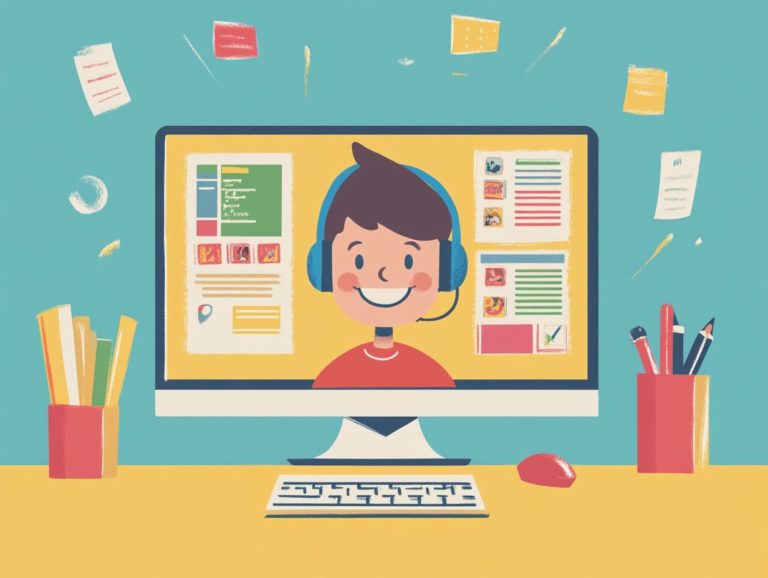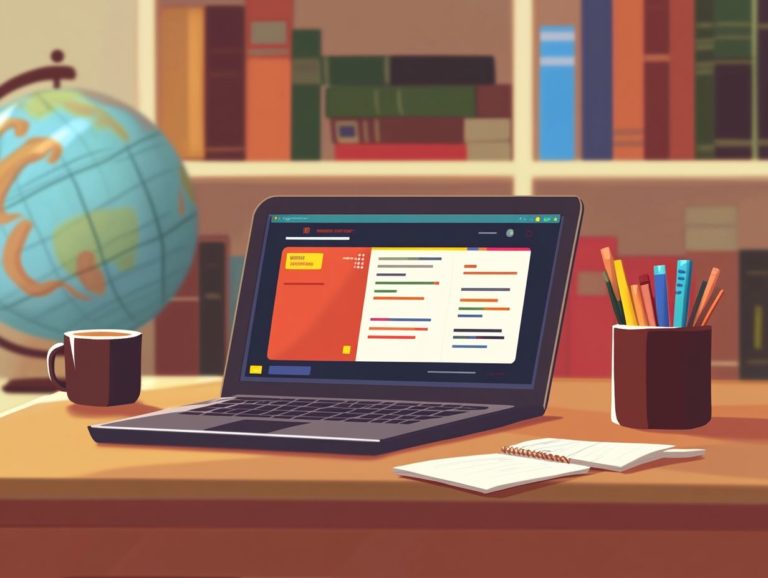5 Best Practices for Note-Taking in Language Learning
Effective note-taking is crucial in your language learning journey. It helps you remember vocabulary and concepts while keeping your studies organized.
This article covers five best practices that can boost your note-taking skills, from staying consistent to using visual aids.
You will learn why regular reviews are important, discover common mistakes to avoid, and find out how technology can improve your learning experience.
Whether you’re just beginning or looking to refine your approach, these tips will help you become a more efficient language learner.
Contents
- Key Takeaways:
- 1. Use a Consistent Format
- 2. Write Down Key Vocabulary
- 3. Take Notes in the Language You Are Learning
- 4. Use Visual Aids and Diagrams
- 5. Review and Summarize Your Notes Regularly
- Why Is Note-Taking Important in Language Learning?
- What Are Some Common Mistakes to Avoid When Taking Notes in Language Learning?
- How Can Note-Taking Help with Retention and Recall?
- What Are Some Tips for Organizing and Managing Language Learning Notes?
- How Can Technology Be Incorporated into Language Learning Notes?
- What Are Some Other Effective Study Strategies for Language Learning?
- Frequently Asked Questions
- 1. What are the 5 best practices for note-taking in language learning?
- 2. Why is using a consistent format important in note-taking for language learning?
- 3. Is it important to write notes in the target language when learning a new language?
- 4. How can visual aids be incorporated into note-taking for language learning?
- 5. How often should I review and revise my notes when learning a new language?
- 6. Are there any specific note-taking techniques that work best for language learning?
Key Takeaways:

- Stay organized! A consistent format makes reviewing notes easy.
- Vocabulary matters! Writing down key words boosts your language skills.
- Immerse yourself! Taking notes in the language you are learning enhances recall and fluency.
1. Use a Consistent Format
Using a consistent format in your note-taking is essential for doing well in your studies. This approach helps you stay organized and makes it easier to review your notes.
In a learning environment, where clarity and structure are important, this practice is even more crucial.
By adopting methods like the Cornell Method or the Outline Method, you can manage your notes more effectively. The Cornell Method encourages you to summarize and reflect on what you’ve learned, making reviews more focused. The Outline Method is great for showing hierarchies and relationships among topics, simplifying navigation through detailed information.
Both techniques streamline your study process and help boost your confidence and overall performance.
2. Write Down Key Vocabulary
Writing down key vocabulary is vital in your language learning journey. It helps you remember important words and reinforces grammar rules.
A strong vocabulary can greatly enhance your active learning experience, allowing you to engage more deeply with the material. You can create connections that aid your memory by associating new words with images or using memory tricks.
Modern note-taking apps like GoodNotes and Evernote offer features that help you organize your vocabulary lists efficiently. You can categorize words by themes, context, or how often you use them, which contributes to a better understanding of the language and helps you express yourself more fluently.
3. Take Notes in the Language You Are Learning
Taking notes in the language you re learning can significantly improve your understanding and retention. It immerses you in the language and encourages active engagement with vocabulary and grammar rules.
By regularly writing down phrases, sentences, and grammar structures, you reinforce what you’ve learned and start to think in that language an essential step toward fluency. You can supercharge this practice by using specific note-taking techniques. For example, the Zettelkasten Method promotes creating interconnected notes, helping you to make deeper connections between concepts.
The Charting Method allows you to organize your notes visually, making it easier to categorize similar grammar structures or vocabulary sets, catering to various learning styles. Together, these strategies create a structured and supportive learning environment, leading to greater proficiency and confidence.
Start implementing these tips today and watch your language skills soar!
4. Use Visual Aids and Diagrams

Incorporating visual aids and diagrams into your note-taking can significantly enhance your understanding and help you remember information better, especially if you’re a visual learner. These tools provide clear representations of complex ideas and relationships, making study material more accessible.
Using different forms of visual aids, such as mind maps (visual diagrams that help organize ideas) and diagrams like the Mapping Method, can completely transform how you organize and grasp information. By breaking topics into manageable segments, you visualize connections and hierarchies, leading to a more intuitive understanding of the content.
With these structured representations, you can easily identify key concepts and subcategories. This approach turns revision into something not only more effective but also more enjoyable. This method promotes active participation in your learning journey, which helps you remember information better and fosters a deeper understanding of the material.
5. Review and Summarize Your Notes Regularly
Make it a habit to review and summarize your notes! This practice not only strengthens your understanding but also makes your study sessions way more effective!
When you summarize, you break down complex concepts into concise materials that are easier to review later.
Consider using various methods to improve this process, like the Boxing Method, which means grouping related ideas into distinct boxes on the page. This simple technique makes connections clearer and helps with comprehension.
Digital note-taking applications such as Microsoft OneNote offer exciting features to organize and categorize your information. They let you add images, links, and audio notes, enriching your study materials.
By integrating these practices, you create a robust framework for revisiting essential content, ultimately boosting your understanding and recall.
Why Is Note-Taking Important in Language Learning?
Note-taking is a vital part of your language learning journey. It helps you organize information and improves your understanding and memory. This practice gives you effective strategies to internalize vocabulary and grammar rules. For more insights, explore 5 tips for staying engaged in language learning. By integrating various note-taking techniques, like the Cornell Method and visual aids, you can elevate your learning experience and build stronger language skills.
The benefits of note-taking go far beyond capturing information; it actively engages you with the material, encouraging you to analyze and synthesize information, rather than just passively consuming it. This involvement solidifies your knowledge, making it easier to recall details during conversations or exams.
By catering to different learning styles whether visual, auditory, or kinesthetic you can choose methods that resonate with you. This personalization enhances your motivation and boosts your effectiveness in studying. Ultimately, strategically incorporating diverse note-taking approaches can significantly enhance your overall success, ensuring that your journey toward language acquisition is both rich and fulfilling.
What Are Some Common Mistakes to Avoid When Taking Notes in Language Learning?
Common mistakes in your note-taking during language learning can seriously hinder your understanding and retention. Disorganized notes, missing key vocabulary, and neglecting to summarize important points can create obstacles. It s vital to adopt effective note-taking strategies.
You might find yourself overwhelmed with information, leading to confusion and frustration. If your notes lack structure, you risk missing vital connections between concepts. Ignoring essential terminology can limit your language acquisition. If you don’t summarize the material, recalling crucial details during reviews can become challenging.
To enhance your language learning experience, consider using techniques such as:
- Color coding
- Using bullet points
- Regularly reviewing your notes
By emphasizing key vocabulary and summarizing consistently, you can significantly boost your retention and understanding, enabling you on your language journey.
Start using these techniques today and watch your language skills soar!
How Can Note-Taking Help with Retention and Recall?

Effective note-taking is essential for enhancing your retention and recall. It encourages you to actively engage with the material, distill key points, and organize your study notes for seamless revision.
As you adopt various note-taking methods, you ll likely notice a significant improvement in your ability to understand and remember information. Techniques like mind mapping allow you to visually represent the relationships between concepts, providing a clearer understanding of the subject matter. This spatial arrangement not only boosts comprehension but also aids memory retrieval during exams or discussions.
Mnemonics are powerful techniques to remember information using patterns or associations, creating memorable associations that simplify the recall of complex information. By weaving these strategies into your note-taking routine, you can elevate your study effectiveness and deepen your connection with the content.
What Are Some Tips for Organizing and Managing Language Learning Notes?
Organizing and managing your language learning notes effectively is essential for maximizing your study efficiency and enhancing your language skills. It provides you with clear pathways to access your materials and insights.
Using digital note-taking apps like Google Keep and Evernote makes this process a breeze! These platforms enable you to create, edit, and store notes effortlessly, ensuring that the information you need is always at your fingertips.
Using note templates streamlines your organization of various topics, helping to maintain consistency across different subjects. By categorizing your information into manageable sections such as vocabulary, grammar rules, and practice exercises you ll be able to retrieve specific data quickly and efficiently.
This structured approach enhances your comprehension and boosts retention by giving you clear reference points during your study sessions.
How Can Technology Be Incorporated into Language Learning Notes?
Incorporating technology into your language learning notes can truly transform how you engage with your materials. Digital note-taking apps like Goodnotes, Evernote, and Microsoft OneNote offer innovative features that elevate your organization and facilitate effective learning strategies.
These tools allow you to categorize your notes with ease while integrating multimedia elements that make the learning experience much more dynamic. For instance, you can effortlessly add audio clips for pronunciation practice or videos for visual learning, tailoring your study sessions to suit your individual needs.
With cloud syncing capabilities saving your notes online so you can access them from any device your notes are accessible across multiple devices, giving you the flexibility to revise on the go. By leveraging such technologies, you can tap into a wealth of educational resources, enhancing your ability to grasp complex concepts and improving your retention skills along the way.
What Are Some Other Effective Study Strategies for Language Learning?
Beyond simply taking notes, you can elevate your language learning experience with a variety of effective strategies. Incorporating active learning techniques, using robust educational resources, and implementing revision strategies can greatly enhance your comprehension and retention.
For instance, engaging in conversation practice allows you to apply your vocabulary and grammar in real-world contexts, significantly boosting your fluency and confidence. Vocabulary drills can further solidify your retention and usage, making the language feel much more accessible.
Don t underestimate the power of language games; they can transform your study sessions into a dynamic and enjoyable experience. This not only fosters collaborative learning but also keeps your motivation at its peak.
By embracing these diverse methods, you not only diversify your study routine but also create opportunities for immediate feedback, all of which enrich your language learning journey.
Frequently Asked Questions

1. What are the 5 best practices for note-taking in language learning?
The 5 best practices for note-taking in language learning are:
- Use a consistent format
- Write in the target language
- Focus on key information
- Use visual aids
- Review and revise regularly
2. Why is using a consistent format important in note-taking for language learning?
Using a consistent format helps with organization and makes it easier to review notes later. It also allows for easy comparison between different topics or lessons.
3. Is it important to write notes in the target language when learning a new language?
Yes! Writing notes in the target language boosts understanding and aids retention. It also promotes language practice and immersion.
4. How can visual aids be incorporated into note-taking for language learning?
Visual aids, like diagrams and charts, make learning more fun. They help connect vocabulary and grammar rules, making them easier to remember.
5. How often should I review and revise my notes when learning a new language?
Make it a habit to review your notes often for better retention! Ideally, do this after each study session. It helps identify any areas that may need more focus.
6. Are there any specific note-taking techniques that work best for language learning?
Note-taking techniques such as mind maps, the Cornell method, and SQ3R can be effective for language learning. Try different methods and see what clicks! Your ideal note-taking style is waiting to be discovered.





